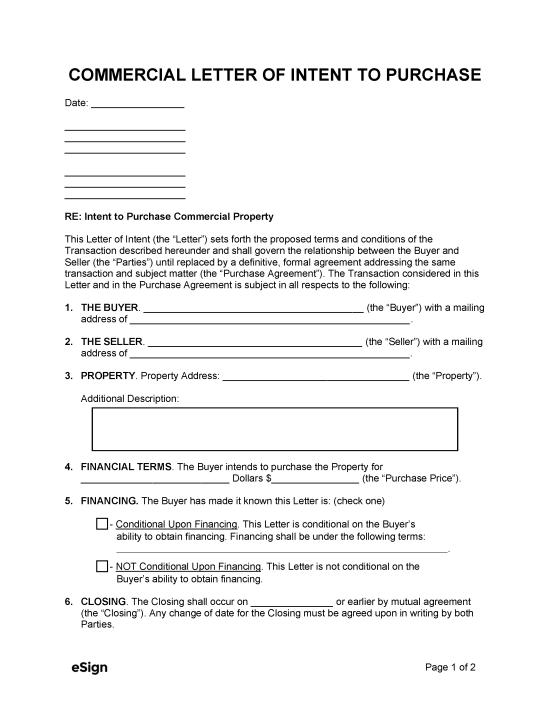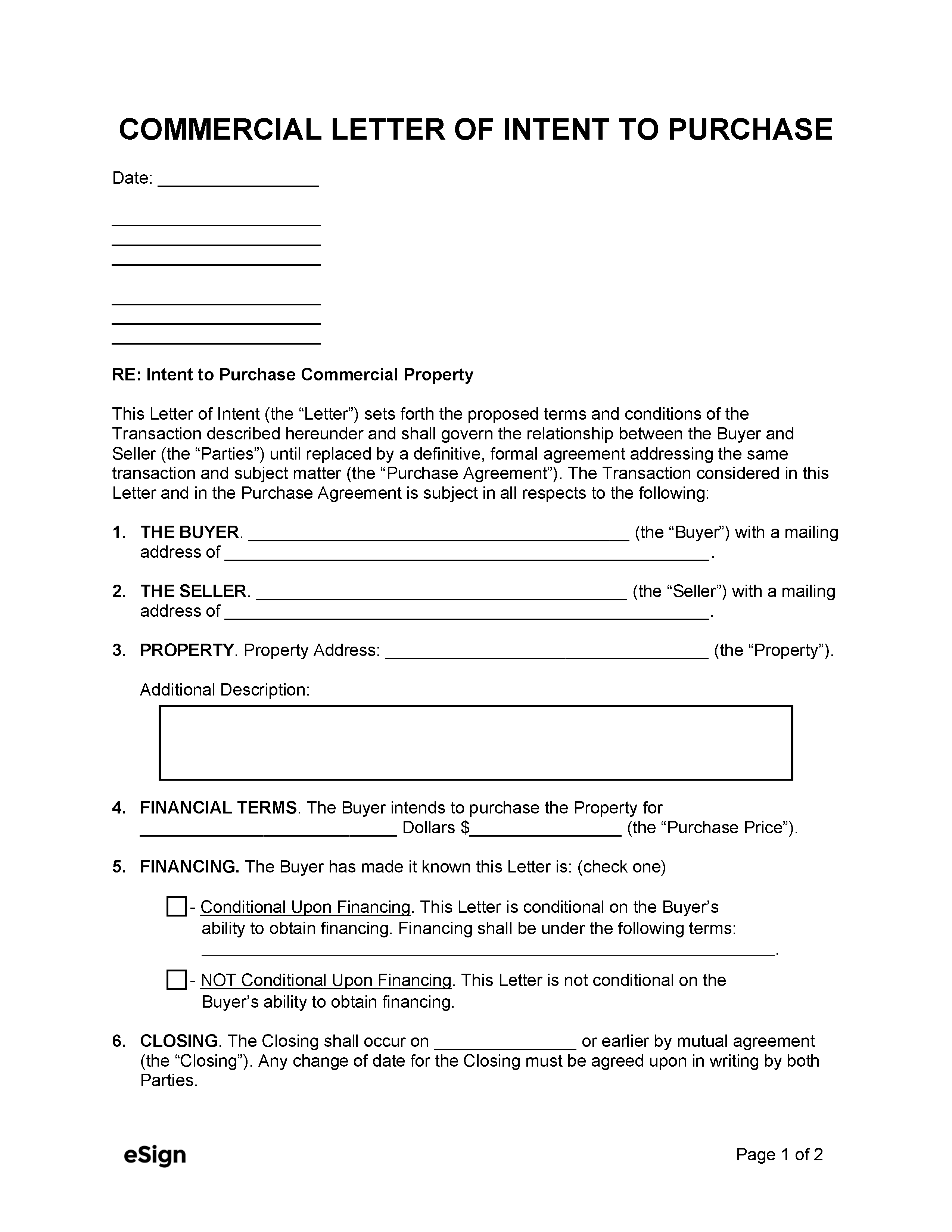What’s Included
- Introductory paragraph – An LOI will usually begin with a formal paragraph that presents the buyer’s intention to buy property from the seller.
- Identification of buyer and seller – The names and addresses of both parties will need to be included.
- Property address – The property’s address must be included, and there will often be a legal description or other information that specifies the location.
- Transaction details – The buyer’s offer will be clarified by specifying their intended purchase price, although the amount may change following negotiations.
- Financing – If the buyer requires financing to complete the transaction, this will need to be mentioned as a contingency of their agreement.
- Closing – The proposed date on which the property will be transferred to the buyer following its sale is often included, as well as which party will cover closing expenses (or whether each party will pay its own closing costs).
- Property inspection – The buyer will generally demand a thorough property inspection before the purchase agreement is drafted. If significant damages are discovered on the property, the parties can renegotiate or cancel the deal altogether (the parties are not bound by a letter of intent to purchase).
- Signatures – While a letter of intent is an informal agreement, once signed, it can bind the seller and buyer to certain terms. For instance, the seller could be prevented from dealing with other interested parties while negotiating with the buyer.
Sample
Download: PDF, Word (.docx), OpenDocument
COMMERCIAL LETTER OF INTENT TO PURCHASE
Date: [DATE]
[SENDER (i.e., BUYER/LESSEE) NAME]
[SENDER STREET ADDRESS]
[SENDER CITY, STATE, ZIP]
[RECIPIENT (i.e., PROPERTY OWNER/LESSOR) NAME]
[RECIPIENT STREET ADDRESS]
[RECIPIENT CITY, STATE, ZIP]
RE: Intent to Purchase Property
This Letter of Intent (the “Letter”) sets forth the proposed terms and conditions of the transaction described hereunder and shall govern the relationship between the Buyer and Seller (the “Parties”) until replaced by a definitive, formal agreement addressing the same transaction and subject matter (the “Definitive Agreement”). The transaction considered in this Letter and in the Definitive Agreement is subject in all respects to the following:
Please note: Any sections that do not apply may be struck through or deleted.
1. THE BUYER. [BUYER NAME] (the “Buyer” or “Lessee”) with a mailing address of [BUYER MAILING ADDRESS].
2. THE SELLER. [SELLER NAME] (the “Seller” or “Lessor”) with a mailing address of [SELLER MAILING ADDRESS].
3. TRANSACTION. This Letter is for the purchase of the Property located at [PROPERTY ADDRESS] (the “Property”) for $[AMOUNT] (the “Purchase Price”).
4. FINANCING. This Letter is: ☐ – Conditional Upon Financing ☐ – Not Conditional Upon Financing.
5. CLOSING. The Closing shall occur on [DATE] (the “Closing”). Any change of date for the Closing must be agreed upon in writing by both Parties.
6. CLOSING COSTS. All costs associated with the Closing shall be the responsibility of (check one) ☐ the Buyer ☐ the Seller ☐ the Parties each bearing their own expenses.
7. POSSESSION. Possession of the Property shall be given on [DATE] (the “Possession”). Any change of date for the Possession must be agreed upon in writing by the Buyer and Seller.
8. STANDSTILL AGREEMENT. Following the execution of this Letter, and until Closing, the Seller shall not negotiate for the sale of the Property with any other party unless either the Parties agree in writing to terminate this Letter, or the Parties fail to sign a Purchase Agreement by [DATE].
9. INTENTION OF THE PARTIES. This Letter sets forth the intentions of the Parties to use reasonable efforts to negotiate, in good faith, a Definitive Agreement with respect to all matters herein. Notwithstanding paragraphs 4 and 8 through 11, which shall be legally binding, any legal obligations with respect to all other matters shall only arise if and when the Parties execute and deliver a Definitive Agreement.
10. GOVERNING LAW. This Letter shall be governed under the laws of the State of [STATE NAME].
11. SIGNATURES.
Seller Signature: ____________________________
Date: [MM/DD/YYYY] Print Name: [SELLER PRINTED NAME]
Buyer Signature: ____________________________
Date: [MM/DD/YYYY] Print Name: [BUYER PRINTED NAME]

